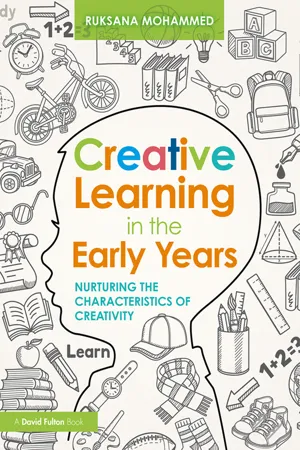
Creative Learning in the Early Years
Nurturing the Characteristics of Creativity
- 268 pages
- English
- ePUB (mobile friendly)
- Available on iOS & Android
About This Book
Taking a fresh look at the role of creativity within the early years, this accessible guide explores what is meant by creativity and considers how creative skills, behaviours, and thinking can be identified and fostered in the individual child. Underpinned by the latest research and policy, chapters illustrate how creative attitudes can be adopted in all subject areas, and opportunities for creativity maximised.
Creative Learning in the Early Years acknowledges the power of creative processes in helping children reach their full potential in the early years and beyond. Photocopiable work tools enable the reader to plan, observe, assess, and record progress as they develop playful and creative approaches, whilst practical advice and demonstrable examples are easily integrated into existing practice. Topics addressed include:
-
- recognising and encouraging creative tendencies
-
- stimulating the child's imagination
-
- developing adult creativity and self-awareness
-
- creating enabling environments and creative spaces
-
- using documentation and planning to inspire creativity.
An exciting and accessible guide which encourages exploration, experimentation, reflection, and development, Creative Learning in the Early Years will support current and future early years practitioners as they discover the rich opportunities opened by creative practice.
Frequently asked questions
Information
1
Creativity and education



- A history of creativity in education and the factory model
- The link of creativity to economic development towards the fourth revolution
- Creativity in educational aims as a twenty-first-century skill and the creativity crisis
- Creativity and early years education
- Bold beginnings
- Advocating for creativity in the early years


Back to the past …
- 1) Agricultural age (farmers) – education was for the very few and was class-bound, i.e. for the rich only. The structure of schooling at that time mirrored monasteries and army life. Research to Explore

- 1995–1996 Wood and Jeffery explored teacher creativity.
- Later, the renowned Anna Craft (1996, 1998, 2000, 2001, 2005) focused on how to nourish the creative teacher and on the essential role of creativity in early childhood.
- Fryer (1996) went on to study teachers’ attitudes towards creativity in their daily professional work.
- Beetlestone (1998) focused on creativity’s place in the early years environment of the classroom.
- 2) Industrial age (factory workers) – a basic level of education was required by production workers; creativity and thinking were not required. The curriculum was modelled on the factory metaphor, with children divided into year groups; knowledge divided into subjects; and progression made through school batches. This still exists today.
- 3) Information age (knowledge workers) – an age we currently live in. Governments view education as a product and a personal investment. Hierarchal approaches to education exist in the form of league tables, with private schools for the rich and mainstream schools for the working class and the poor.
- 4) Conceptual age (creators and empathisers) – an age one needs to prepare for. Pink (2006) believes that to survive in the economy to come, it is not the factory model masses that are needed, but the creators and empathisers that education should be working towards developing.

- 1) The disciplined mind – developed through education to support individuals becoming ‘experts’ in one area of specialism or discipline. One could say that our current teaching of subjects in education represents the beginnings of catering for this type of mind. However, times have changed and there is a need to become interdisciplinary, or multi-disciplinary, in order to gain expertise in multiple disciplines and keep them going.
- 2) The synthesising mind – being able to synthesise huge amounts of information. This includes a wide range of sources and experiences, making decisions about what is important, and combining and communicating information in a meaningful way. Within the synthesising mind will be an area of expertise (discipline), though, which will then know the trusted sources of information within that area and be able to keep an overview of it and see the big picture.
- 3) The creating mind – what this book is really all about. It is the mind that develops new ideas, practices, and experiences, solves problems, innovates, provides fresh thinking and perspectives, and engages in creativity. A mind that adapts to the changing world. However, both the disciplined and synthesising mind play a role within the creating mind, as new and innovative developments in disciplines cannot occur without the ability to be knowledgeable in areas and synthesise the information from it in order to create.
- 4) The respectful mind – ‘responding sympathetically and constructively to differences among groups; seeking to understand and work with those who are different; extending beyond mere tolerance and political correctness’ (Gardner, 2007, p. 157). This mind welcomes social contact, tries to form links, and avoids making judgements. This mind is vital in exploring diverse experiences across communities and cultures in order to embed them further in changing disciplines and creating.
- 5) The ethical mind – considers sophisticated moral issues in an abstract way. Decisions, behaviour, and beliefs of those around you can influence the development of this mind and provide role models for it.

Table of contents
- Cover
- Title
- Copyright
- Dedication
- Contents
- Figures and tables
- Acknowledgements
- About the author
- Preface
- Introduction
- 1 Creativity and education
- 2 Defining creativity
- 3 The creative child
- 4 Creativity and imagination
- 5 The creative adult
- 6 The creative curriculum
- 7 Creative planning and assessment
- 8 Creative spaces
- 9 Creative approaches
- 10 Creative inquiry and reflection
- Appendix: Work tools
- References
- Index